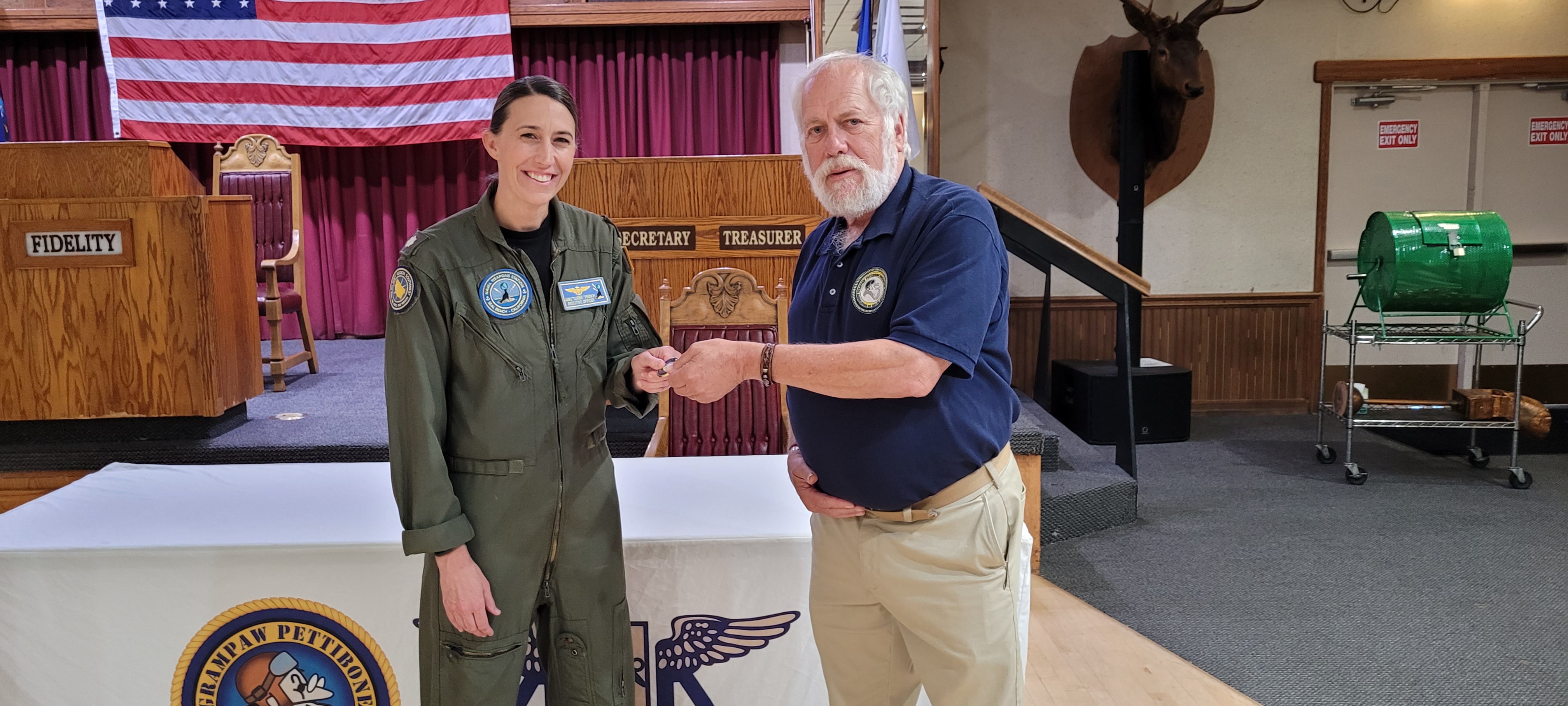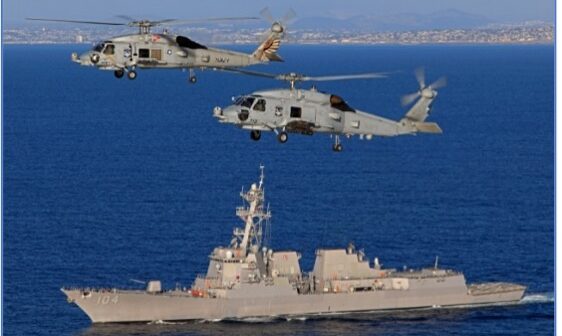In spite of the decline in attendance, Grampaw Pettibone Squadron continues to be a source of information of historical and military related events. Undeterred, our leader, Tim Brown, continues to send out meeting notices. He is blessed with speakers and presentations that will keep your attention..
On Thursday, July 13, 2023, the squadron was privileged to have Commander Jamie French, USN present a talk on ‘The Role of the Anti-Submarine Helicopter in Patrolling the Deep’. CDR French is a 20-year veteran of the United States Navy, having graduated from the United States Naval Academy with a Bachelor’s degree in 2003. She acquired a Master’s Degree from John Hopkins University in 2013. CDR French entered aviation training and received her aviation warfare “Wings of Gold” in September 2005 after which she was assigned to her first operational tour with HELICOPTER ANTI-SUBMARINE SQUADRON LIGHT FOUR FIVE (HSL-45) in San Diego, California.
Additional sea tours and land-based leadership assignments enhanced both her flying skills and leadership, reinforcing her knowledge and capability in support of her current role as Executive Officer for the Naval Weapons Station Seal Beach (NAVWPNSTA).
CDR French presented a program on the Helicopter Maritime Strike Squadron (HSM) and the role that the Lockheed-Martin MH-60R Naval Helicopter fills in the organization. The talk provided an overview of the, Command Structure and Missions as well as Major Systems of the aircraft.
The CDR began by providing an overview of command structure: There are two types of squadrons under the HSM: Carrier Squadron and Expeditionary Squadron. Out of a typical 260 Officer and Enlisted population, some 190 are staffed on carriers. Carrier squadrons answer to both their type commanders and the carrier air wing commanders. The remaining 70 personnel within Expeditionary Squadrons fill helicopter detachments on cruisers, destroyers, and other helicopter-capable non–aircraft carriers. Aircraft distribution have 11 aircraft, 5 Carrier Based and 6 onboard non-carrier vessels in groups of 2.
The organization structure of the current detachment HSM-71 differs from the previous HSM-60. One difference between 71 and previous 60B dets is that the MH-60R aircraft are owned and tasked by the Combat Air Group (CAG) as part of the air wing. There should be a greater level of integration (Air Tasking Order, etc).


In speaking about the unit missions, CDR French noted that there are two primary missions: Anti-Surface Warfare (SUW) and Anti-Submarine Warfare (ASW). There is a significant difference between earlier models of the SH-60B to the most recent MH-60R. Two major differences are: the current models are generally heavier, and the gear is more modular. This modular feature allows for a smoother transition in loading external components to meet mission requirements.
The versatility of the aircraft and detachment training prepared the unit for secondary missions. The unit and aircraft are capable to support Search and Rescue (SAR), Medical Evacuation (MEDEVAC), Vertical Replenishment (VERTREP), Naval Surface Fire Support (NSFS) and Communications Relay (COMREL). Weight limits may be encountered in supporting VERTREP assignments. Depending on mission requirements the onboard equipment needs may change.
In speaking about mission requirements, our speaker introduced a number of systems that are part of the aircraft mission inventory, beginning with the APS-153 Radar /IFF. This multi-mode system contains seven separate modes: Coastal, Search Short /Long, Pericope Short / Long, Automatic Radar Periscope Detection (ARPDD) and ISAR. Coastal mode shows enhanced land video returns (helpful for navigation).
The CDR documented each of the radar modes. The Search Long is the most used for general purposes, while Search Short provides better resolution at short range (self-contained approaches, etc). The Periscope Short/Long are able to identify periscopes from background sea clutter. ISAR (Inverse synthetic-aperture radar) is a radar technique using radar imaging to generate a two-dimensional high-resolution image of a target and allows for measurement and classifying contacts.
Other features include Frequency Agile, Data Fusion and IFF interrogation. Frequency Agile is the ability to quickly shift operating frequencies to account for either natural or man-made signal interference. Radar Data Fusion combines multiple radar sources to enhance target identity and tracking and IFF interrogation provides a system internalized feature to identify friendly forces in an operating area without requiring a separate external system.
One concern that has been expressed is that ISAR is a CW (continuous waveform) and could look like a targeting or fire control radar to some ES (Electronic Warfare) systems.
CDR French introduced the ALQ-210 ESM (Electronic Support Measure) system. This is a receive only multi-mission system which provides proven situational awareness and threat warning with Electronics Intelligence. It autonomously scans the environment allowing for a high probability of detection and accurate identification.
The CDR was asked about crew requirements. In addition to the pilot and co-pilot, there can be an additional two crew for anti-submarine warfare and three for anti-surface warfare role. The crew would run the radar and ASW suite. The co-pilot runs the problem sets. A small crew but well qualified.
 The next system mounted on the nose of the aircraft is the AAS-44C(V)2 MTS/FLIR. This is a multispectral targeting system and uses a full-motion video camera for long-range surveillance and high-altitude acquisition, tracking and laser designation. It contains three sensor spectra features for: Day TV, Low Light TV and Mid-wave IR. Additional features include Boresight LRD (Laser Range Designator), Near LR LTM (Laser Target Marker) and Eye-Safe LRF (Laser Range Finder). The system is also Gyro Stabilized and includes an Automatic Video Tracker.
The next system mounted on the nose of the aircraft is the AAS-44C(V)2 MTS/FLIR. This is a multispectral targeting system and uses a full-motion video camera for long-range surveillance and high-altitude acquisition, tracking and laser designation. It contains three sensor spectra features for: Day TV, Low Light TV and Mid-wave IR. Additional features include Boresight LRD (Laser Range Designator), Near LR LTM (Laser Target Marker) and Eye-Safe LRF (Laser Range Finder). The system is also Gyro Stabilized and includes an Automatic Video Tracker.
Operational devices for the MH-60R includes up to 25 pneumatically launched buoys. The family of buoy models includes the following features:
- BTsonobuoy is an expendable thermal gradient measurement sonobuoy
- DICASS (Directional Command Activated Sonobuoy) is an aircraft dropped listening device using hydrophones to listen for the sounds made by a submarine.
- AIRBOC is an airborne chaff dispenser usable as a decoy target for hostile missiles, a confusion target against hostile search radars, target masking coverage, or corridor protection screening.
- MLM – launched either day or night to provide visual marks on the ocean’s surface. They may be used to mark the course of enemy submarines during an Antisubmarine Warfare mission or a survivor in the water during Search and Rescue missions.
- DIFAR– sonobuoy is an expendable and non-repairable sonobuoy. The DIFAR sonobuoy provides a magnetic bearing to the signal of interest to the monitoring unit(s) and can be used for search, detection, and classification.
- VLAD – sonobuoy – Vertical Line Array DIFAR that gives PASSIVE bearing data and is used for deep water ops.
- SUS – an underwater sound signal device which is an expendable electro-acoustic device and provides one-way acoustic communications with submarines.
CDR French described the buoy launch features and monitoring. The operation allows for simultaneous reception and processing of 8 buoys. However, most operations are not equipped with more than two different devices, based on the mission and monitor those units that are launched. Equipment used to detect submerged targets was discussed by the CDR. The AN/ALQ-22 Airborne Low Frequency Sonar (ALFS) is the primary undersea warfare (USW) sensor of the MH-60R multi-mission helicopter. Communication with other aircraft and surface force is very broad.
- The CDR provided an overview beginning with standard UHF/VHF(Clear/Secure) radios.
- HAVEQUICK is an ECM-resistant frequency-hopping system used to protect military aeronautical mobile (OR) radio traffic.
- SINCGARS primary role is voice transmission between surface and airborne command and control assets.
- The use of satellite communication (Satcom Direct) provides secure, world-class global satellite communications& connectivity solutions to multiple service environments.
- Relay and DF provides for a simple signal for locating ship transmissions and through a direction finding feature the ability to return to the surface force that has been on the move.
- Through the installation of a C-Band and Ku-Band datalink, video image can be broadcast to the surface force and provide real time image.
- Another source of transmitted information is Link-16 which uses Time Division Multiple Access (TDMA) to provide multiple, simultaneous communication paths through different nets. It is considered the standard by which other systems are measured for secure, airborne situational awareness.
- Positive situational awareness is provided through a multi-functional IFF device.
- AIS receivers pick up radio signals from Class A and Class B AIS transponders and translate them into data sentences to be read by computers or AIS-enabled chart-plotters.
Most everything the MH-60R detects is immediately transmitted back to Navy ships via the Real-time Common Data Link (CDL) “Hawklink”. This includes; Radar, MTS and Acoustic signals.
In speaking about the various systems used to detect, report and respond to possible hostile surface or submerged craft, the use of Aircraft Survivability Equipment (ASE) is part of the MH-60R equipment array. This is related electronic devices and systems designed to protect aircraft and crews by detecting and defeating threats from infrared (IR) guided (heat seeking) missiles, laser-guided RF missiles, and unguided munitions. The CDR listed the following: Missile Warning / Laser Detection using the AAR-47, Radar Warning from the ALQ-210, Counter Measure Dispenser Systems (CMDS), ALE-47 using a flare, chaff and radar jamming expendables and the Infrared Countermeasures (IRCM), ALQ-144 which is designed to protect aircraft from infrared homing (“heat seeking”) missiles by confusing the missiles’ CDR French pointed out the weapons systems available when the need to engage hostile intent is detected. Mounted on one side of the MH-60R are the Hellfire, AGM-114 air-to-ground missile system. Up to 8 missiles can be loaded on the aircraft. Additional weapons are the light-weight Mk 46/54 anti-submarine torpedo, door guns, GAU-21 .50 caliber and/or M-240 7.62mm machine guns.
 Speaking about the aircraft range and limitation, the CDR listed the range from shore to a ship as 200nm and 150nm when returning from ship to shore. A 100nm radius for mission operations with a minimum of 600 pounds of fuel on deck.
Speaking about the aircraft range and limitation, the CDR listed the range from shore to a ship as 200nm and 150nm when returning from ship to shore. A 100nm radius for mission operations with a minimum of 600 pounds of fuel on deck.
CDR French is currently the Executive Officer for the Naval Weapons Station Seal Beach (NAVWPNSTA).





